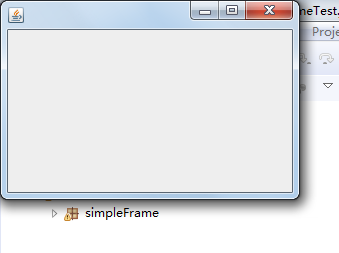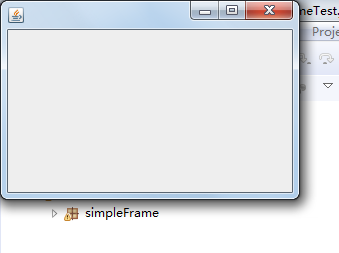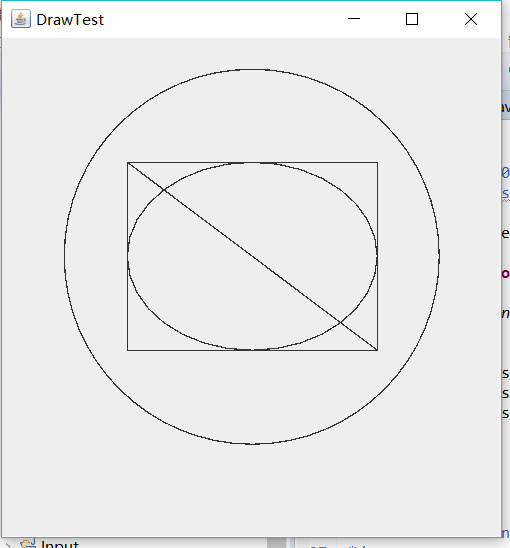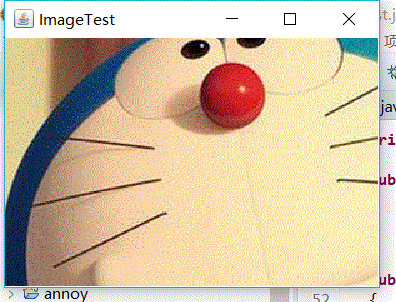李曉菁201771010114《面向物件程式設計(java)》第十二週學習總結
一:理論部分
1.(1) 使用者介面(User Interface)使用者與計算機系統(各種程式)互動的介面
(2)圖形使用者介面(Graphical User Interface)以圖形方式呈現的使用者介面
2.AWT:Java 的抽象視窗工具箱( Abstract WindowToolkit, AWT)包含在java.awt包中,它提供了許多用來設計GUI的元件類和容器類。
. AWT庫處理使用者介面元素的方法:把圖形元素的建立和行為委託給本地GUI工具箱進行處理。
. 應用AWT編寫依賴於本地使用者介面元素GUI會暴露出一些缺陷。例如,選單、滾動條和文字域這些
使用者介面元素,在不同的平臺上,操作行為上存在一些微妙的差異。
3.Swing:
Swing使用者介面庫是非基於對等體的GUI工具箱。
Swing具有更豐富並且更方便的使用者介面元素集合。
Swing對底層平臺的依賴很少,因此與平臺相關的bug很少。
Swing會帶來交叉平臺上的統一視覺體驗。
Swing類庫被放在javax.swing包裡。
4.AWT與Swing的關係
大部分AWT元件都有其Swing的等價元件。
Swing元件的名字一般是在AWT元件名前面新增一個字母“J”,如:JButton,JFrame,JPanel等。
二..建立框架
1.元件:構成圖形使用者介面的元素,拿來即用用圖形表示(能在螢幕上顯示,能和使用者進行互動)
2.通常把由Component類的子類或間接子類建立的物件稱為一個元件。
3.容器:容器是Java中能容納和排列元件的元件。常用的容器是框架(Frame,JFrame)
例:Frame fra = new Frame(“這是一個視窗”);
4.新增元件:
Container類提供了一個方法add(),用來在容器類元件物件中新增其他元件。
容器本身也是一個元件,可以把一個容器新增到另一個容器裡,實現容器巢狀。
5.框架(Frame)的建立:
(1)建立空框架:在Java中,常採用框架(Frame)建立初始介面,即GUI的頂層視窗。
AWT庫中有一個基於對等體的Frame類。該類的Swing版本為JFrame,JFrame是Frame子類。
(2)框架定位與框架屬性:
定位:
—常用Component類的setLocation和setBounds方法
常用屬性
—Title:框架標題
—IconImage:框架圖示
(3)確定框架的大小:通過呼叫Toolkit類的方法來得到螢幕尺寸資訊
6.在元件中顯示資訊
在AWT中可呼叫add()方法把元件直接新增到AWTFrame中,在Swing中元件則新增到內容窗格里。
其中內容窗格是用來新增元件的,新增程式碼如下:
Container contentPane = getContentPane();
Component c=…;contentPane.add(c);. 使用者也可以自行建立一個元件類,並在元件上進行繪製,此時需要過載paintComponent()。
使用者的自建元件也可新增到內容窗格里。
. paintComponent(Graphics g)定義在JComponent類中,該方法在視窗需要重新繪圖時(如擴大視窗或極小化視窗),被系統自動呼叫
.. paintComponent()方法被呼叫時,系統就自動產生一個Graphics型別的引數,傳遞給paintComponent方法中的引數g。
元件的啟用與可見性:
public void setEnabled(boolean b):設定元件是否可被啟用。
當引數b取值true時,元件可以被啟用。
當引數b取值false 時,元件不可啟用。
預設情況下,元件是可以被啟用的。
public void setVisible(boolean b):設定元件在該容器中的可見性。
當b取值true時,元件在容器中可見。
當b取值false時,元件在容器中不可見。
除了Window型元件外,其它型別元件預設是可見的。
實驗十二 圖形程式設計
實驗時間 2018-11-14
1、實驗目的與要求
(1) 掌握Java GUI中框架建立及屬性設定中常用類的API;
(2) 掌握Java GUI中2D圖形繪製常用類的API;
(3) 瞭解Java GUI中2D圖形中字型與顏色的設定方法;
(4) 瞭解Java GUI中2D影象的載入方法。
2、實驗內容和步驟
實驗1: 匯入第10章示例程式,測試程式並進行程式碼註釋。
測試程式1:
l 執行下列程式,觀察程式執行結果。
| import javax.swing.*; public class SimpleFrameTest { public static void main(String[] args) { JFrame frame = new JFrame(); frame.setBounds(0, 0,300, 200); frame.setDefaultCloseOperation(JFrame.EXIT_ON_CLOSE); frame.setVisible(true); } } |

package demo; import javax.swing.*; public class SimpleFrameTest { public static void main(String[] args) { JFrame frame = new JFrame(); frame.setBounds(0, 0, 300, 200);//設定視窗位置和大小 frame.setDefaultCloseOperation(JFrame.EXIT_ON_CLOSE);//設定預設的關閉操作 frame.setVisible(true); } }SimpleFrameTest

l 在elipse IDE中除錯執行教材407頁程式10-1,結合程式執行結果理解程式;與上面程式對比,思考異同;
l 掌握空框架建立方法;
l 瞭解主執行緒與事件分派執行緒概念;
l 掌握GUI頂層視窗建立技術。

package simpleFrame; import java.awt.*; import javax.swing.*; /** * @version 1.33 2015-05-12 * @author Cay Horstmann */ public class SimpleFrameTest { public static void main(String[] args) { EventQueue.invokeLater(() -> { SimpleFrame frame = new SimpleFrame(); frame.setDefaultCloseOperation(JFrame.EXIT_ON_CLOSE);//設定預設的關閉視窗 frame.setVisible(true);//給值為true使得window可見 }); } } class SimpleFrame extends JFrame { private static final int DEFAULT_WIDTH = 300; private static final int DEFAULT_HEIGHT = 200;//設定兩個私有屬性,確定視窗的寬和高 public SimpleFrame() { setSize(DEFAULT_WIDTH, DEFAULT_HEIGHT);//構造器返回的值為設定元件大小, } }SimpleFrameTest

測試程式2:
l 在elipse IDE中除錯執行教材412頁程式10-2,結合程式執行結果理解程式;
l 掌握確定框架常用屬性的設定方法。

package sizedFrame; import java.awt.*; import javax.swing.*; /** * @version 1.34 2015-06-16 * @author Cay Horstmann */ public class SizedFrameTest { public static void main(String[] args) { EventQueue.invokeLater(() -> { JFrame frame = new SizedFrame(); frame.setTitle("SizedFrame"); frame.setDefaultCloseOperation(JFrame.EXIT_ON_CLOSE);//設定預設的關閉 frame.setVisible(true); }); } } class SizedFrame extends JFrame { public SizedFrame() { // get screen dimensions Toolkit kit = Toolkit.getDefaultToolkit(); Dimension screenSize = kit.getScreenSize(); int screenHeight = screenSize.height; int screenWidth = screenSize.width; // set frame width, height and let platform pick screen location setSize(screenWidth / 2, screenHeight / 2);//設定視窗的位置在螢幕高和寬的1/2處 setLocationByPlatform(true);//值給為true,說明按上述操作執行 // set frame icon Image img = new ImageIcon("icon.gif").getImage();//將GIF格式的圖片放在根目錄下,則顯示視窗的圖示為圖片 setIconImage(img); } }sizedFrame

測試程式3:
l 在elipse IDE中除錯執行教材418頁程式10-3,結合執行結果理解程式;
l 掌握在框架中新增元件;
l 掌握自定義元件的用法。

package notHelloWorld; import javax.swing.*; import java.awt.*; /** * @version 1.33 2015-05-12 * @author Cay Horstmann */ public class NotHelloWorld { public static void main(String[] args) { EventQueue.invokeLater(() -> { JFrame frame = new NotHelloWorldFrame(); frame.setTitle("NotHelloWorld"); frame.setDefaultCloseOperation(JFrame.EXIT_ON_CLOSE); frame.setVisible(true); }); } } /** * A frame that contains a message panel */ class NotHelloWorldFrame extends JFrame { public NotHelloWorldFrame() { add(new NotHelloWorldComponent()); pack(); } } /** * A component that displays a message. */ class NotHelloWorldComponent extends JComponent { public static final int MESSAGE_X = 75; public static final int MESSAGE_Y = 100; private static final int DEFAULT_WIDTH = 300; private static final int DEFAULT_HEIGHT = 200;//設定所要畫的圖在視窗中的位置 public void paintComponent(Graphics g) { g.drawString("Not a Hello, World program", MESSAGE_X, MESSAGE_Y);//文字helloworld是畫上去的並非是一個文字形式。 } public Dimension getPreferredSize() { return new Dimension(DEFAULT_WIDTH, DEFAULT_HEIGHT); } }helloworld

測試程式4:
l 在elipse IDE中除錯執行教材424 -425頁程式10-4,結合程式執行結果理解程式;
l 掌握2D圖形的繪製方法。

package draw; import java.awt.*; import java.awt.geom.*; import javax.swing.*; /** * @version 1.33 2007-05-12 * @author Cay Horstmann */ public class DrawTest { public static void main(String[] args) { EventQueue.invokeLater(() -> { JFrame frame = new DrawFrame(); frame.setTitle("DrawTest"); frame.setDefaultCloseOperation(JFrame.EXIT_ON_CLOSE); frame.setVisible(true); }); } } /** * A frame that contains a panel with drawings */ class DrawFrame extends JFrame { public DrawFrame() { add(new DrawComponent());//add方法用來新增元件 pack();//用於調整此視窗的大小,以適合其子元件的首選大小和佈局 } } /** * A component that displays rectangles and ellipses. */ class DrawComponent extends JComponent { private static final int DEFAULT_WIDTH = 400; private static final int DEFAULT_HEIGHT = 400; public void paintComponent(Graphics g)//Java中所有的繪圖必須呼叫graphics實現 { Graphics2D g2 = (Graphics2D) g; // draw a rectangle double leftX = 100; double topY = 100; double width = 200; double height = 150; Rectangle2D rect = new Rectangle2D.Double(leftX, topY, width, height); g2.draw(rect); // draw the enclosed ellipse Ellipse2D ellipse = new Ellipse2D.Double(); ellipse.setFrame(rect); g2.draw(ellipse); // draw a diagonal line g2.draw(new Line2D.Double(leftX, topY, leftX + width, topY + height)); // draw a circle with the same center double centerX = rect.getCenterX(); double centerY = rect.getCenterY(); double radius = 150; Ellipse2D circle = new Ellipse2D.Double(); circle.setFrameFromCenter(centerX, centerY, centerX + radius, centerY + radius); g2.draw(circle); } public Dimension getPreferredSize() { return new Dimension(DEFAULT_WIDTH, DEFAULT_HEIGHT); } }draw

測試程式5:
l 在elipse IDE中除錯執行教材432頁-433程式10-5,結合程式執行結果理解程式;
l 瞭解2D圖形中字型的設定的方法;

package font; import java.awt.*; import java.awt.font.*; import java.awt.geom.*; import javax.swing.*; /** * @version 1.34 2015-05-12 * @author Cay Horstmann */ public class FontTest { public static void main(String[] args) { EventQueue.invokeLater(() -> { JFrame frame = new FontFrame();//font類中包含字型的大小顏色等 frame.setTitle("FontTest"); frame.setDefaultCloseOperation(JFrame.EXIT_ON_CLOSE); frame.setVisible(true); }); } } /** * A frame with a text message component */ class FontFrame extends JFrame { public FontFrame() { add(new FontComponent()); pack(); } } /** * A component that shows a centered message in a box. */ class FontComponent extends JComponent { private static final int DEFAULT_WIDTH = 300; private static final int DEFAULT_HEIGHT = 200; public void paintComponent(Graphics g) { Graphics2D g2 = (Graphics2D) g; String message = "Hello, World!"; Font f = new Font("Serif", Font.BOLD, 36); g2.setFont(f); // measure the size of the message FontRenderContext context = g2.getFontRenderContext(); Rectangle2D bounds = f.getStringBounds(message, context); // set (x,y) = top left corner of text double x = (getWidth() - bounds.getWidth()) / 2; double y = (getHeight() - bounds.getHeight()) / 2; // add ascent to y to reach the baseline double ascent = -bounds.getY(); double baseY = y + ascent; // draw the message g2.drawString(message, (int) x, (int) baseY); g2.setPaint(Color.LIGHT_GRAY); // draw the baseline g2.draw(new Line2D.Double(x, baseY, x + bounds.getWidth(), baseY)); // draw the enclosing rectangle Rectangle2D rect = new Rectangle2D.Double(x, y, bounds.getWidth(), bounds.getHeight()); g2.draw(rect); } public Dimension getPreferredSize() { return new Dimension(DEFAULT_WIDTH, DEFAULT_HEIGHT); } }font

測試程式6:
l 在elipse IDE中除錯執行教材436頁-437程式10-6,結合程式執行結果理解程式;
l 瞭解2D圖形影象的顯示方法。

package image; import java.awt.*; import javax.swing.*; /** * @version 1.34 2015-05-12 * @author Cay Horstmann */ public class ImageTest { public static void main(String[] args) { EventQueue.invokeLater(() -> { JFrame frame = new ImageFrame(); frame.setTitle("ImageTest"); frame.setDefaultCloseOperation(JFrame.EXIT_ON_CLOSE); frame.setVisible(true); }); } } /** * A frame with an image component */ class ImageFrame extends JFrame { public ImageFrame() { add(new ImageComponent()); pack(); } } /** * A component that displays a tiled image */ class ImageComponent extends JComponent { private static final int DEFAULT_WIDTH = 300; private static final int DEFAULT_HEIGHT = 200;//設定兩個私有屬性,寬和高 private Image image; public ImageComponent() { image = new ImageIcon("blue-ball.gif").getImage();//只有在根目錄下放置名為blue-ball,格式為GIF的圖片時,關閉按鈕才起到作用,並能關閉。 } public void paintComponent(Graphics g) { if (image == null) return; int imageWidth = image.getWidth(null); int imageHeight = image.getHeight(null); // draw the image in the upper-left corner g.drawImage(image, 0, 0, null); // tile the image across the component for (int i = 0; i * imageWidth <= getWidth(); i++) for (int j = 0; j * imageHeight <= getHeight(); j++) if (i + j > 0) g.copyArea(0, 0, imageWidth, imageHeight, i * imageWidth, j * imageHeight); } public Dimension getPreferredSize() { return new Dimension(DEFAULT_WIDTH, DEFAULT_HEIGHT); }//返回兩個私有屬性 }image

實驗2:課後完成PTA平臺題目集:2018秋季西北師範大學面向物件程式設計(Java)練習題集(ch6-ch9)
實驗總結:通過本週的學習,我學到了Java GUI中框架建立及屬性設定中常用類的API;掌握Java GUI中2D圖形繪製常用類的API;瞭解Java GUI中2D圖形中字型與顏色的設定方法;
瞭解Java GUI中2D影象的載入方法。同時在學長的帶領下,學會了如何看某一個方法或者屬性的具體用途,受益匪淺。

